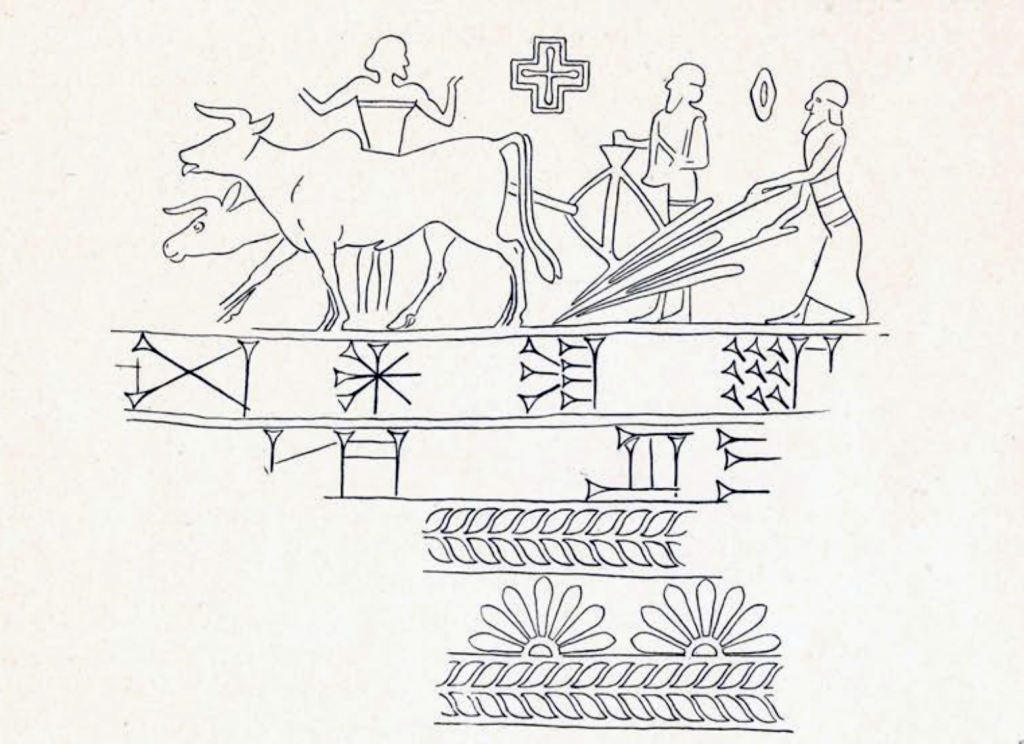An exceedingly interesting seal impression depicting a plow, drawn by two oxen, is found on a clay tablet with a cuneiform inscription in the University Museum. This tablet belongs to the Cassite period of Babylonian history, and is dated in the fourth year of the reign of Nazi-Maruttash, who lived in the fourteenth century before Christ. The seal used to make the impression must have been an unusually large one, for it measured about two and one-eighth inches in length. After the surface of the soft clay tablet had been covered with writing this seal, which was of the usual cylindrical form, was run like a roller over the inscription on both sides and the four edges of the tablet, which measure about 2 3/4 x 4 1/2 inches. That is, the entire document was covered with the impressions of different parts of this large seal. Unfortunately, there is no complete impression of the seal on the tablet. Some of the parts were repeated a number of times,but other parts seem to be entirely wanting. Moreover, the surface of a portion of the tablet has suffered considerably, due probably to the moisture in the earth, or exposure to the atmosphere after the tablet had been excavated. The accompanying drawing of the seal impression (Fig. 1) was made after a careful study of the different traces found on the various parts of the tablet by Mr. Herman Faber, Miss Baker and the writer.

The plow gang consists of three men. The one depicted larger in size than the others is doubtless the chief. He appears to be driving the animals, as is indicated by his raised arm, perhaps holding a whip. Another, having a bag over his shoulder, is in the act of feeding the tube or grain drill, through which the seed was dropped into the furrow made by the plow, which is being guided by the third man. The animals drawing the plow, known as alpu, “ox,” in the inscription, are in use in Babylonia at the present time. It is the Zebu or humped bull (bos indicus).
The individual for whom the seal was cut regarded himself as a devotee of Nin-Sar, the god of vegetation, as the first line of the inscription shows (Arad-NIN-SAR). Unfortunately the name of the owner in the second line is so imperfectly preserved that it cannot be read.
For some time other representations of the plow in antiquity have been known, but in no instance is it so accurately represented as in this seal impression. A boundary stone of Meli-Shipak, of the Cassite period, recently found at Susa, contains the picture of a plow, which has hitherto been regarded as the earliest. It does not seem to have a tube. There is another picture of a plow found on an undated fragment belonging to the same period. Later representations of plows with tubes are found on monuments of Sennacherib and Esarhaddon. Plows similar to the one found in this seal impression are in use in Syria at the present time. The plow on the Museum tablet, here discussed, is the earliest known, being about a century earlier than the one on the boundary stone belonging to the reign of Meli-Shipak.
It is also interesting to note that one of the latest inventions of our Western civilization whereby the grain is sown by machinery was already anticipated by ancient Babylonians at least thirty-three centuries ago. In fact the simple Babylonian device accomplished what no single piece of modern machinery does, in that it combined the processes of plowing and sowing.
A. T. C.

